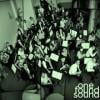
Set a 30-something to catch a 30-something: Luring millennials to events preoccupies a lot of musical organizations these days, and the millennial-led chamber orchestra One Found Sound has its own variant of a successful formula.
The orchestra, founded by members Georgeanne Banker, Sarah Bonomo, and Sasha Launer, proclaims that it “provides equitable and barrier-free music in the San Francisco Bay Area,” and its website bears the legend “the future of classical music” with the word “classical” struck through in red. And Saturday night’s concert, titled “Aurora,” leaned heavily on a playbook that cultural organizations have been following ever since millennials got old enough to be taken seriously.

Staged at the small but inviting Heron Arts Gallery, the audience was welcomed by the founders, given funny and engaging introductions to the music by Banker, and encouraged to clap whenever they wanted, take photos with their phones, get drinks from the bar, and meet the musicians afterward.
The music was still the center of the show, but enhanced by immersive lighting and visuals by Max Savage in collaboration with John Lawrence Taylor. There’s no point in being a stick-in-the-mud about this. Millennials and Gen-Z artists seek out collaborators across different art forms and as an audience they pretty much expect that. The lighting was quite thoughtfully integrated into the musical content, not provided as a simple background.

Clarice Assad’s Impressions provided the spirit-lifting energy of a great concert opener. Composed in 2008 on commission from the New Century Chamber Orchestra and its leader Nadia Salerno-Sonnenberg, where Assad was composer-in-residence, it’s described as a get-to-know-you piece, kind of a miniconcerto for orchestra in which Assad refracts her own style through the musicians, as she gets to know them. Filled with ingratiating melody, the piece whips through moods and ideas, with nods to jazz and guitar-plucking in the variations first movement, Brazilian music in the second, Hollywood in the third, and classical contrapuntal form in the perpetuum mobile fourth movement. The return of the opening melody, unfolding from a motivic kernel in the fourth movement, is a gift to the audience, also the last touch in an assured and tightly organized composition.

Born in 1990, composer Viet Cuong already sports commissions from a dozen high-level new music organizations, but the song “Thu Dieu” (Fishing in autumn, 2017), based on a famous poem by Nguyen Khuyen, was his first musical dive into the Vietnamese culture of his parents. It’s a song about patience and paying attention to nature. Not unexpectedly, Cuong’s melody is mostly pentatonic, but the chamber ensemble accompaniment, grounded by the steady but light tread of Jennifer Ellis’s harp is much more diverse, all glinting half-light, murmurs, and evocative stillness. All of this set the stage for soprano Bich-Vân Nguyen, whose showstopping performance came from a place of deep emotional connection. Her microtonal melodic inflections, precise hand gestures, and liquid diction, rendered Cuong’s composition vividly, a testament to the power a great performance can have on an audience’s appreciation of new music.
You can’t appeal to a broad audience as an orchestra without including some classics, and so the full orchestra was onstage for the finale, Beethoven’s Symphony No. 8, This performance was as boisterous as you could ask for, not lacking in finesse, but missing some of the tonal refinement of a top-tier ensemble. Not that we cared on Saturday night. With Kashi Elliott leading from her first violin position (this orchestra stands through its shows) the rhythms were tight and the joint was jumping. Mission accomplished, OFS.
NB: The violin leader in the Beethoven Symphony 8 was Kashi Elliott, not Annamarie Arai-Lopez as originally reported. We regret the error.






